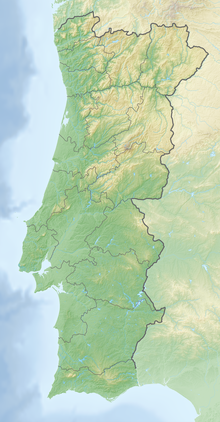Rock-dome tombs of São Pedro do Estoril
Location of the rock-domed tombs of São Pedro do Estoril in Portugal. |
The two rock-dome tombs of São Pedro do Estoril ( Portuguese Grutas artificiais de São Pedro do Estoril ) form one together with the rock-dome tombs of Alapraia (approx. 1.6 km north) and the Gruta do Poço Velho (approx. 4.5 km west) remarkable concentration of this graves typus on the south coast of Lisbon peninsula . Further away, but with comparable features, the rock tombs of the necropolis of Carenque (approx. 14 km northeast) and the rock- domed tombs of Palmela (approx. 40 km southeast) north of Setúbal were uncovered.
location
The graves were dug in the steep eastern slope of the cliff Pedra do Sal , which juts out into the sea . The site is located in São Pedro do Estoril in the municipality ( Portuguese Freguesia ) Cascais e Estoril , district ( Portuguese Concelho ) Cascais , a good 4.5 km east of the district town.
Monument preservation
On April 25, 1944, the site was discovered by Leonel Ribeiro. Due to the continuous erosion of the steep slope, both graves were already badly damaged and were archaeologically examined in the same year in collaboration with Vera Leisner and Afonso do Paço . The entrances to the graves are walled up to protect against further destruction and are not accessible. At the height of the cliff, a reconstructed floor plan and an explanation board refer to the location and importance of the two graves.
Findings
Grave 1 ( Portuguese Gruta 1 ) has an approximately oval plan of 4.7 × 4.3 m, while Grave 2 ( Portuguese Gruta 2 ) has an almost round plan with a diameter of 4.5 m. Both graves were carved out of the rock in the shape of a dome; the previously existing corridors had already fallen victim to erosion at the time of the excavation.
Both graves were used as burial places for several centuries, with the majority of the buried being buried in a crouched position. The examination of a total of five bone samples with the radiocarbon method revealed an occupancy period of the graves from the middle of the 4th millennium BC. Until the end of the 3rd millennium BC BC, that is, they were used from the Neolithic to the end of the Copper Age or bell-cup culture .
Finds
In addition to numerous ceramic fragments, several extraordinary finds were found in grave 1 in particular:
- A set of four gold spiral rings.
- Two bowls with a foot and decoration in the tradition of bell beakers, which have so far remained without parallel in Portugal.
- A cylindrical idol made of bones .
- A limestone idol .
- Eleven polished buttons made of bone, which when found formed a row about 1 m long and probably belonged to the trimmings of one of the deceased's clothing.
In addition, a copper point, copper and bone punch , an arm protection plate , polished stone tools and flint tools were found.
Some of the finds are now on display in the Museu Condes de Castro Guimarães museum in Cascais.
literature
- Vera Leisner, Afonso de Paço a. Leonel Ribeiro: Grutas artificiais de S. Pedro do Estoril . Lisbon 1964.
- Archaeological guide through Portugal . In: Thomas G. Schattner (Ed.): Cultural history of the ancient world . tape 74 . Philipp von Zabern, Mainz 1998, ISBN 3-8053-2313-1 , p. 144 f .
- further reading under Portal do Arqueólogo sv Bibliografia.
Individual evidence
- ^ Paula Noé: Gruta do Poço Velho. Direção-Geral do Património Cultural - Sistema de Informação para o Património Arquitectónico, 1991, accessed December 17, 2018 (Portuguese).
- ↑ a b c d e Archaeological guide through Portugal . In: Thomas G. Schattner (Ed.): Cultural history of the ancient world . tape 74 . Philipp von Zabern, Mainz 1998, ISBN 3-8053-2313-1 , p. 144 f .
- ↑ a b c Grutas de S. Pedro do Estoril . Retrieved December 17, 2018 (Portuguese, with images of the most important finds).
- ↑ São Pedro do Estoril (Grutas de) . Direção-Geral do Património Cultural - Portal do Arqueólogo, accessed December 17, 2018 (Portuguese).
- ↑ Victor S. Gonçalves: Construir para os mortos. Grutas artificiais e antas na península de lisboa. Algumas leituras prévias. (= Estudos Arqueológicos de Oeiras . No. 17 ). Oeiras 2009, p. 247-260 (Portuguese).
- ^ Joaquina Soares and Carlos Tavares do Silva: O grupo de Palmela no quadro da ceramica campaniforme em Portugal. (= O Arqueólogo Português . Series 3, Volume 7-9). Lisbon 1977, p. 101-112 (Portuguese).
Web links
Coordinates: 38 ° 41 ′ 37.6 " N , 9 ° 22 ′ 17.8" W.


